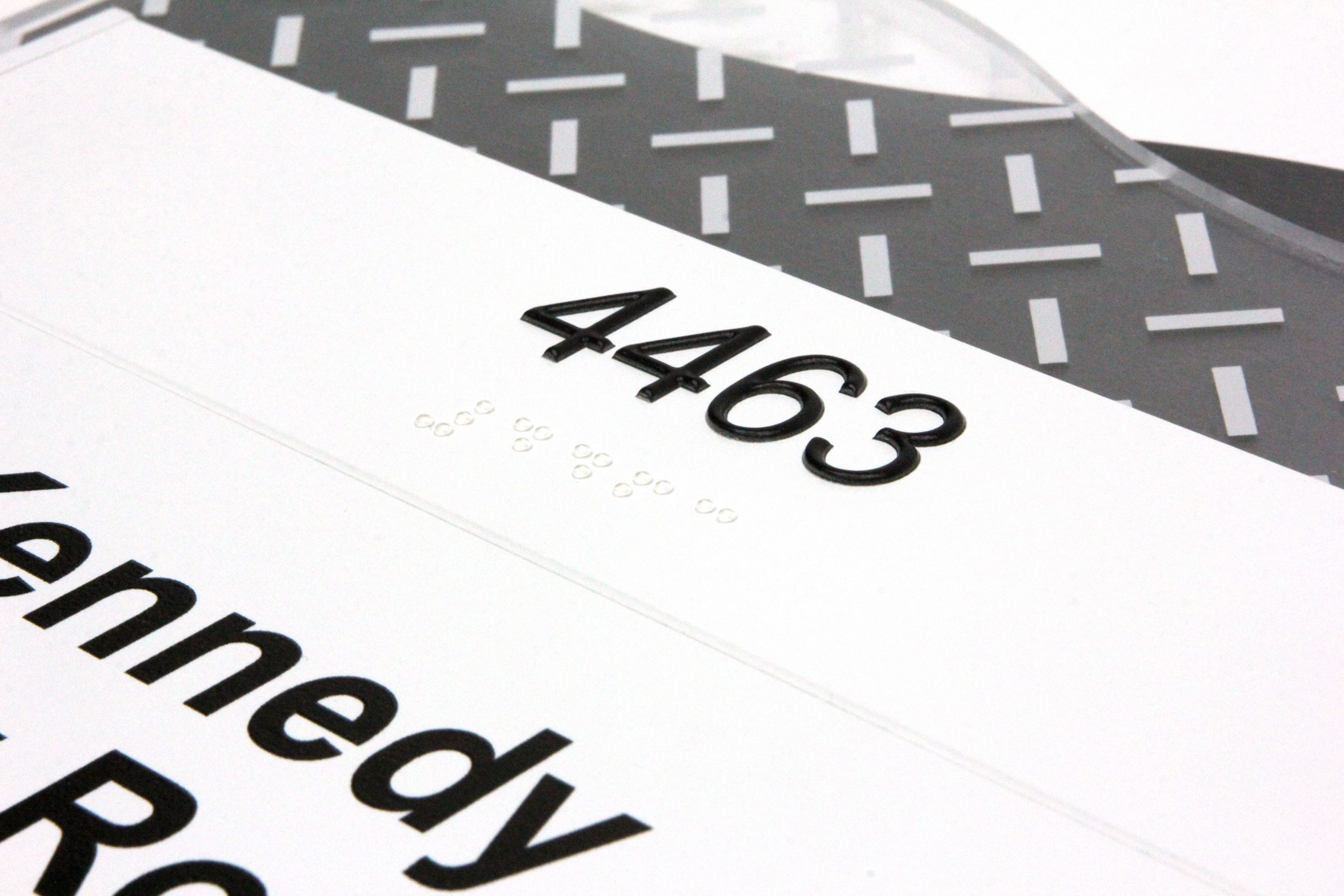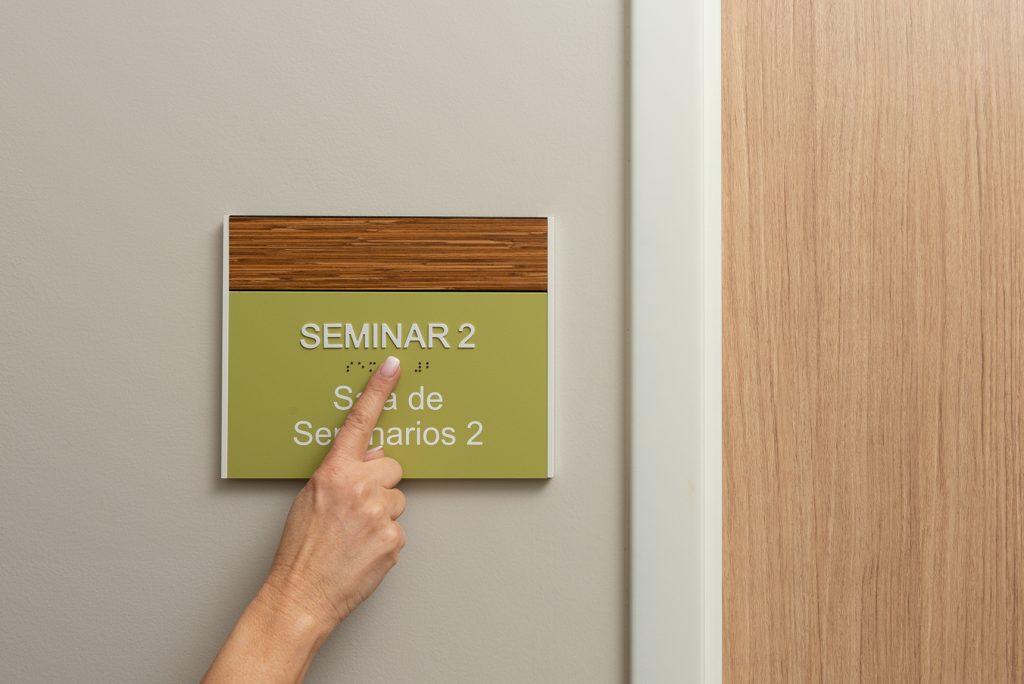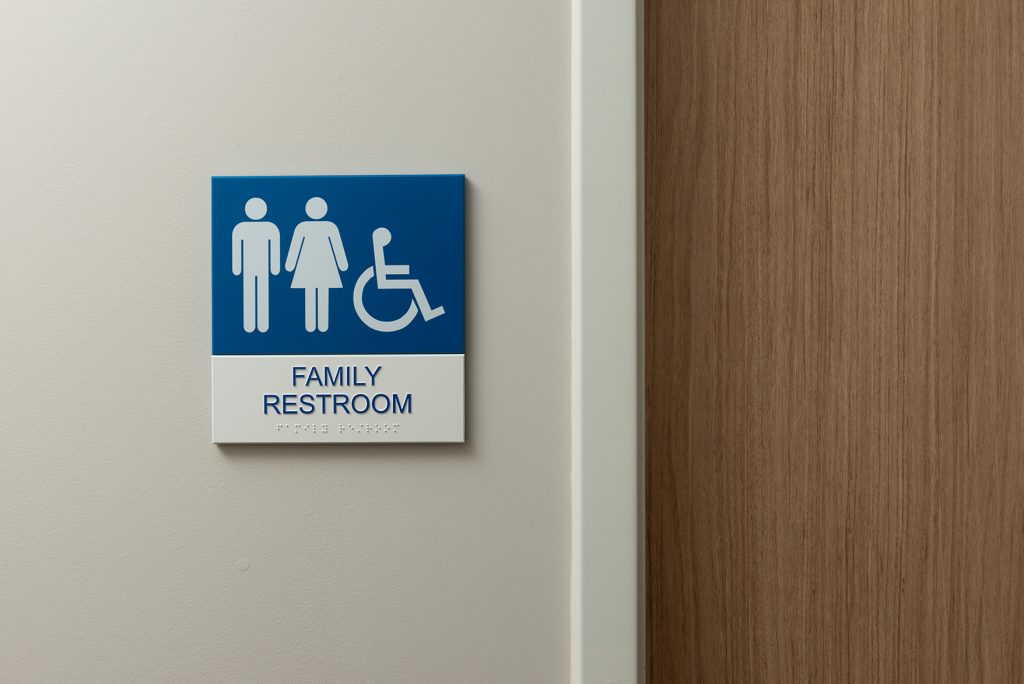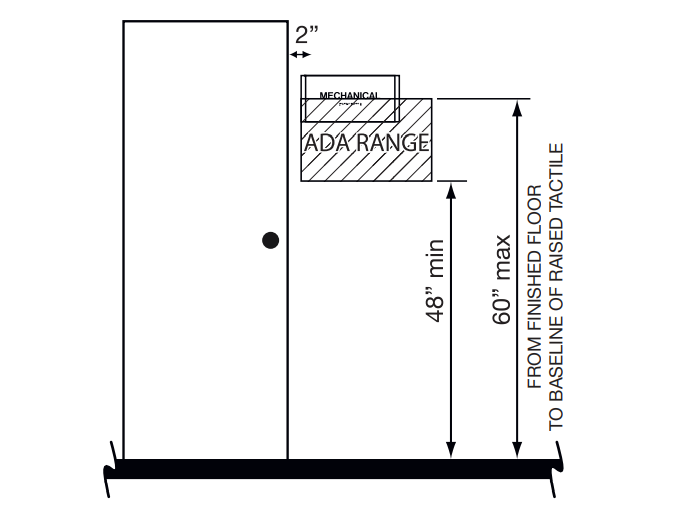ADA SIGNAGE
State-of-the-Art Equipment and Processes
2/90 Sign Systems proudly presents our newest ADA copy application, ADA Direct Print with superior adhesion and durability.
ADA DIRECT PRINT (ADP): UV/LED-cured inks are digitally printed directly to insert material producing ADA-compliant graphics with 1/32” thick raised characters and fully domed Grade II Braille dots. Insert and substrate materials include painted ABS, PTEG, and acrylic, as well as metal, wood, and stone laminates, and more. ADP uses state-of-the-art direct to insert, 3D-printing technology, creating a bonded copy application with superior adhesion and detailed dimensional graphics.
ADA Direct Print Features:
- UV/LED-cured dimensional 1/32” Raised characters
- Integral color
- Exterior grade
- Detailed dimensional graphics with fully domed Grade II Braille
- Suitable for a wide range of custom substrate materials
- Sustainable process
Is your signage ADA-compliant?
2/90 Sign Systems can help!
If a sign identifies a permanent room or space of a facility (including exits), directs, or informs about functional spaces or accessible features of the facility, it must comply with the ADA.
HISTORY: The Americans with Disabilities Act (ADA) was implemented in the early 1990s to protect the civil rights of the disabled. The intent of the law as it pertains to signage is to ensure access to goods and services by mandating identification standards including character size, color contrast, sign location, and tactile copy for readability.
The Department of Justice amended the Americans with Disabilities Act on September 15, 2010. The revisions clarify and refine issues that have arisen since its implementation over twenty years ago. These changes are referred to as “2010 Standards for Accessible Design” (SAD) and are enforced today for new construction and alterations.
TACTILE CHARACTERS
know your ABC's.
Characters cannot have sharp or abrasive edges. Other guidelines for raised characters include: 1/32 inch minimum above their background, uppercase, copy style to be sans serif and characters cannot be expanded, extended, italic, oblique, script, highly decorative, or of other unusual form. Minimum height for raised characters is 5/8 inch with a 2-inch maximum.

BRAILLE
you can feel it.

There are two types of Braille. The original, Grade 1 Braille uses full spelling. And the new ADA-complaint standard is Grade 2 Braille which consists of Grade 1 Braille and 189 contractions. 2/90 uses the new standard when creating Braille. New guidelines require Braille dots to be rounded or domed. Braille dots need to be positioned 3/8 of an inch directly below the corresponding text and be the same color as the background.
PICTOGRAMS
seeing is believing.
Pictograms need a vertical field of 6 inches. Raised characters and Braille cannot be located in this field. The equivalent verbal description needs to be placed directly below the pictogram field.

INSTALLATION
makes a difference.

Previously, ADA signs were mounted at 60 inches to the center of the sign. 2010 Standards provide for a range of 48 to 60 inches above the finished floor measured from the baseline of the highest tactile character. This change provides for visual consistency of sign heights.
The bottom of overhead signage must clear 80 inches minimum above the finished floor (AFF). Wall-mounted signs must be mounted a minimum of 27 inches AFF and a maximum height of 80 inches, with a maximum protrusion into the pathway of 4 inches. The bottom of overhead signage must clear 80 inches minimum above the finished floor (AFF).
FAQ
Did you know?
1. What is ADA
The American with Disabilities Act (ADA) was implemented in the early 1990s to protect the civil rights of the disabled. The intent of the law as it pertains to signage is to ensure access to goods and services by mandating identification standards including character size, color contrast, sign location and tactile copy for readability.
2. How does ADA relate to ABA and DOD's ABA?
ADA guidelines are enforced by the Department of Justice in places of public accommodation, commercial facilities and in state or local government facilities. Architectural Barriers Act (ABA) code is used by federal government facilities and buildings being leased with federal funds. The Department of Defense (DOD) uses the ABA code for military facilities. ADA, ABA, and DOD’s ABA codes have the same signage requirements.
3. What is known as the 2010 Standards?
The Department of Justice amended the American with Disabilities Act on September 15, 2010. The revisions clarify and refine issues that have arisen since its implementation over twenty years ago. These changes are referred to as the “2010 Standards”. Effective March 15, 2012, the 2010 Standard will be enforced for new construction and alterations. Please note, formal compliance is administered at the state and local levels, therefore, revisions may have already been adopted. Some states and municipalities are permitted to adopt accessibility codes even more stringent than the 2010 Standards with the approval of the U.S. Department of Justice.
4. How do the new regulations affect signage?
As an industry leader of ADA signage, 2/90 Sign Systems has implemented the changes over the last two years to ensure a seamless transition. Changes include a detailed definition of tactile characters, new location and mounting heights for signs, and minimum character heights determined by viewing distances.
5. Do all signs need to be ADA compliant?
No. Several signs are exempt from ADA codes including building addresses, building directories, company names and logos, menus, occupant names, seat and row designations in assembly areas, signs in parking facilities (except accessible parking space signs), signs not located in public use areas in detention and correctional facilities, and temporary signs which are used for seven days or less. Learn more at www.ADA.gov
6. What sign types need to follow ADA guidelines?
All permanent rooms and spaces are required to have an ADA compliant sign providing identification. Life safety signs identifying doors at exit passage ways, discharge, and stairwells are required to be ADA compliant and include raised characters and Braille copy. Overhead, flag-mounted, and wall-mounted signs that direct or identify need to follow ADA guidelines but do not require tactile copy.
7. Do temporary signs need to be ADA compliant?
No. The new ADA defines permanent signage as an identification sign representing destinations for more than seven days. Temporary signs (signs used less than seven days) do not need to be ADA compliant.
8. Does ADA require a name or a number to identify a space?
Rooms that contain equipment that cannot easily be moved, like kitchens and restrooms, are identified by name. For spaces that may change, like offices or cubicles, alphanumerical addresses are acceptable.
9. Does Cubicle signage need to be ADA compliant?
If cubicle furniture is not bolted to the floor, ceiling or any other part of the architecture, then it is a movable piece of furniture and not covered by the Standard. If the cubicle is not fixed then the sign attached to the cubicle is not permanent and therefore would not need to comply with the Standard. However, 2/90 recommends compliance as if the sign were fixed as you have an obligation to provide effective communication and possibly reasonable accommodations for employees under the regulations. If cubicle furniture is affixed to the structure, alphanumerical addresses are acceptable; only the number must be ADA compliant not the changing name.
10. Do I have to update my current signage?
If signage in existing facilities already complies with the 1991 ADA, and is not being altered, you are not required to update it with changes in the 2010 Standards.
11. I need to purchase a new sign; do I have to follow the new regulations?
Yes. If altering existing signage (i.e. ordering new sign or replacement parts), new regulations are required to remain ADA compliant.
12. What are the newest ADA guidelines for Raised Characters on signage?
Characters cannot have sharp or abrasive edges. Other guidelines for raised characters include: 1/32 inch minimum above their background, uppercase, copy style to be sans serif and characters cannot be expanded, extended, italic, oblique, script, highly decorative, or of other unusual form. Minimum height for raised characters is 5/8 inch with a 2 inch maximum.
13. Is my Copy Style ADA compliant?
2/90 has taken the guess work out of determining if character proportions, height and stroke thickness are ADA compliant by providing a list of standard ADA compliant fonts. Please refer to 2/90’s Copy Style Chart located at the end of FAQ section. Example: Arial is ADA compliant; Century Schoolbook includes serifs so it is not ADA compliant.
14. Is Helvetica Medium (HMC) Copy Style ADA compliant?
No. Though once compliant and considered the industry standard ADA copy style, HMC is no longer compliant due to the thickness of the stroke. 2/90 recommends using Helvetica Regular (HRC) for visual consistency.
16. What type of Braille is used for ADA compliant signage?
There are two types of Braille. Grade 1 Braille is full spelling. Grade 2 Braille consists of Grade 1 Braille and 189 contractions. Grade 2 Braille is ADA compliant. 2/90 uses the new standard when creating Braille. New guidelines require Braille dots to be rounded or domed. Braille dots needs to be positioned 3/8 of an inch directly below the corresponding text.
17. What are the guidelines for Visual Characters?
When raised characters and Braille copy are not mandated but signs provide direction or life safety, guidelines for Visual Characters are required. Visual characters and their background need to follow these guidelines: non-glare finish, contrast with their background, uppercase or lowercase or a combination of both, copy style to be conventional in form, and characters cannot be expanded, extended, italic, oblique, script, highly decorative, or of other unusual forms.
18. Is white copy on a tan background ADA compliant?
2010 Standards only require characters to contrast with their background with either light characters on a dark background or dark characters on a light background. The previous recommendation of 70 percent color contrast is no longer mandated, however, it is considered good accessible design. A lawsuit can still be made, even if not explicitly in the code. Therefore, since white copy on a tan background is only 63 percent, 2/90 does not recommend it. Please refer to 2/90’s Color Contrast Values PDF located at the end of the FAQ section.
19. What size does my copy need to be for ADA compliance?
The new codes allow for letter heights to better fit their environment. Minimum character height is 5/8 inch and 2 inches maximum for raised characters. For visual characters, a range of 5/8 inch to 2 inches is used for wall-mounted signs. Overhead signage has a 2-inch minimum character height along with height requirements above 3 inches for longer distances.
20. Are there any ADA changes for symbol signage?
Yes. Pictograms need a vertical field of 6 inches. Raised characters and Braille cannot be located in this field. The equivalent verbal description needs to be placed directly below the pictogram field.
21. At what height do ADA signs need to be installed?
Previously, ADA signs were mounted at 60 inches to the center of the sign. 2010 Standards provide for a range of 48 to 60 inches from the bottom to the top of sign text. This change provides for visual consistency of sign heights.
22. What are minimum height clearances for ADA signage?
The bottom of overhead signage must clear 80 inches minimum above the finished floor (AFF). Wall-mounted signs must be mounted a minimum of 27 inches AFF and a maximum height of 80 inches, with a maximum protrusion into the pathway of 4 inches.
23. Where do ADA signs need to be installed in relationship to a door?
When mounting ADA-compliant signage, the sign location is relative to door type and swing path. The new ADA provides greater guidance for the placement of signs, allowing tactile signs to be placed on the push side of doors with a closing mechanism. This change clarifies the issue of signs on restroom doors.
- Single Door: Sign shall be next to the door on the latch side.
- Double Doors (one active leaf): Sign shall be located on the inactive leaf.
- Double Doors (two active leaves): Sign shall be to the right of the right-handed door.
- Push Doors: Sign shall be on the push side of doors with closers and without hold-open devices.
- Signs for doors without wall space (on the latch side of the single door or at the right side of double doors) shall be mounted on the nearest adjacent wall.
- The mounting location for such signage shall be so that a person may approach within 3 inches of signage without encountering protruding objects or standing within the swing of a door.
24. Are there any ADA changes in Life Safety signage?
Yes. Safety regulations in buildings are constantly changing. The International Building Code (IBC) is governed by the International Code Council and ADA. Please check with your local authorities for requirements.
15. How do I know if character and line spacing is ADA compliant?
2/90 has adopted the 2010 Standards guidelines for character and line spacing as our standard to ensure compliancy.
25. Do I need evacuation maps in my facility?
Although codes vary from state to state, it is highly recommended. Evacuation maps, when required, must include a floor plan with an evacuation route, location of safety items, outside meeting location, and emergency protocols. Evacuation maps do not require raised characters or Braille.
26. Does my facility need luminous markings?
Again, it varies from state to state but is highly recommended. When required, it includes luminous egress path markings, symbols in stairwells, and other egress points for all new and existing institutional, educational, corporate, hotel, public assembly, and R-1 residential buildings.
27. Is ADA stairwell signage necessary?
Yes. A tactile sign is required next to each door inside a stairwell identifying floor level and stairwell. Many local fire codes require a visual-compliant minimum sign size of 18 inches high by 12 inches wide for each floor in all stairwells identifying floor level, stair level, roof access, and level of exit. Depending on building type and state code, these signs may be required to be photoluminescent. Since local ordinances override federal, please verify with your municipality.
28. Who can I ask additional ADA specific questions not covered in this section?
ADA questions can be directed to info@290signs.com or call Customer Service at 800.777.4310. Technical assistance is also available directly from the Access Board through their question line: TA@access-board.gov, or by phone at 800.872.2253. Please visit the links provided below for detailed information.
RESOURCES AND HELPFUL LINKS
need something else?
ADA questions can be directed to info@290signs.com or call Customer Service at 800.777.4310. Technical assistance is also available directly from the Access Board through their question line: TA@access-board.gov, or by phone at 800.872.2253.
Please visit the links provided below for detailed information.
- 2/90’s ADA Copy Style Chart (PDF)
- 2/90’s Color Contrast Value Chart (PDF)
- DOJ’s (Department of Justice) 2010 Standard Chapter Seven: Communication Elements as it pertains to signage (PDF)
- ADA and ABA Accessibility Guidelines for Buildings and Facilities as it pertains to signage (PDF)
- To download the complete 2010 Standard, visit http://www.ada.gov/2010ADAstandards_index.htm
- To download the complete guide, visit at ADAAG at http://www.access-board.gov/adaag/html/adaag.htm